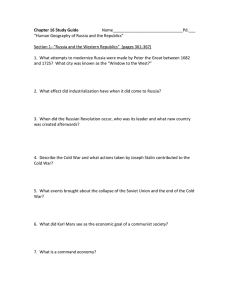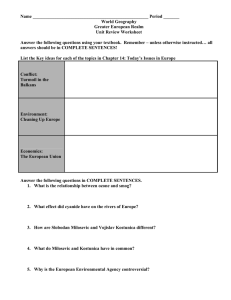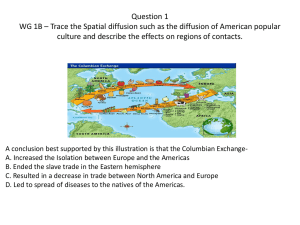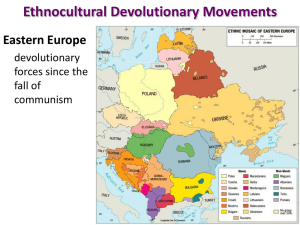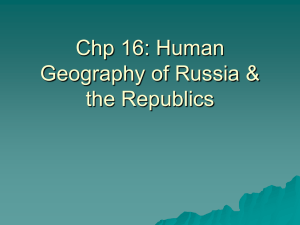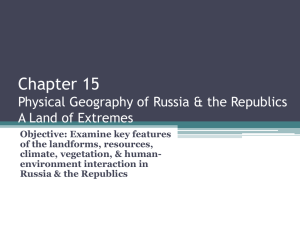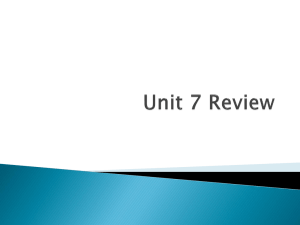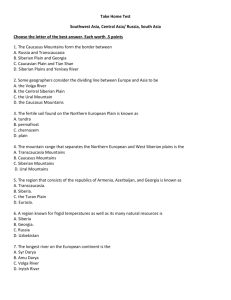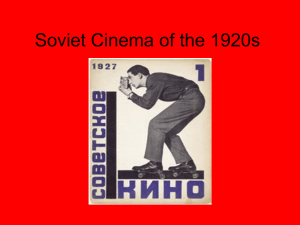File - Ms. Cherry`s Homework Page
advertisement
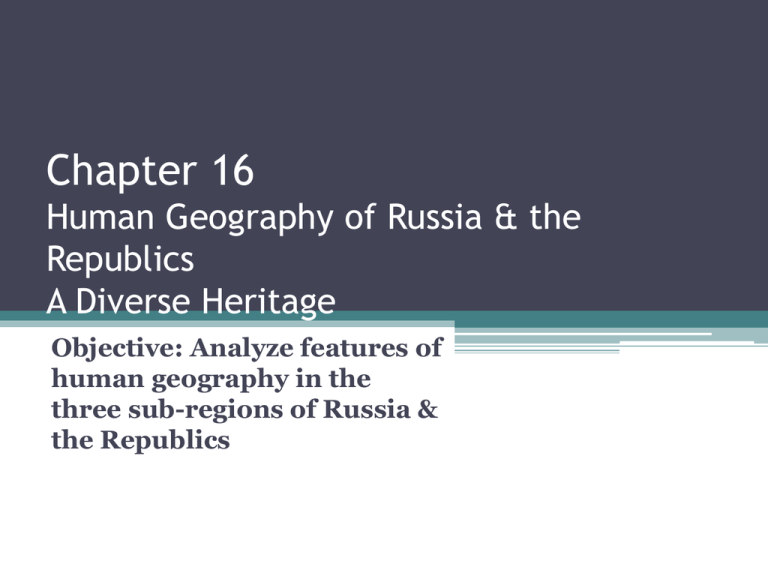
Chapter 16 Human Geography of Russia & the Republics A Diverse Heritage Objective: Analyze features of human geography in the three sub-regions of Russia & the Republics Chapter 16 Section 1 Russia & the Western Republics Vocabulary: Baltic Republics, Czar, Russian Revolution, USSR, Cold War, Command Economy, & Collective Farm Objective: Describe the cultural background & achievements of Russia & the Western Republics A History of Expansion • Vikings from Scandinavia established a settlement near Kiev • The Vikings adopted the customs of the local Slavic population • Mongols halted the expansion of the Russians until Ivan the Great put an end to their rule • Many people belonged to different ethnic groups, spoke different languages, & practiced different religions • Czar (emperor/king of Russia) • Peter the Great made impressive strides toward modernizing Russia The Rise & Fall of the Soviet Union • In 1917, the Russian Revolution occurred, ending the rule of the czars • The Russian Communist Party took control of the government • In 1922 the USSR (Union of Soviet Socialist Republics) was created • The leader Joseph Stalin led the Soviet Union to victory in WW2 • Tensions rose between the United States & the Soviet Union creating the Cold War • The Cold War lasted until the fall of the Soviet Union in 1991 • The Soviet Union was divided into 15 independent republics Building a Command Economy • The Communists were inspired by the idea of a Command Economy replacing Capitalism • In a communist society, citizens would own property together & everyone would share the wealth • Command Economy: central government makes all the decisions • The government created collective farms where laborers worked together • Under this huge transformation, millions of citizens starved while only a few benefited • People tried to rise in protests but were stopped the government • Historians estimate that Stalin was responsible for the death of 14 million people A Rich Culture • Russia has the greatest ethnic diversity of the region’s republics • Russians make up the largest ethnic group with about 80% of the population • Orthodox Christianity is the most popular religion • However, the region also has Buddhist, Muslims, & Jews • Art & Architecture style are unique in Russia • Russia is known for their ballet companies Tradition & Change in Russian Life • The region’s people have begun to enjoy more social & cultural opportunities • They can now keep up with new movies, music, & clothing trends from around the world • However, they still favor a traditional way of life • 30% of the population own dachas or vacation homes in the countryside • They also enjoy visiting a banya (sauna, steam room, icy cold pool, then hot tea) Nuclear Explosion At Chernobyl • On April 28, 1986 a Swedish engineer was startled when a radiation detector went off as he entered his office • After checking the radiation on his clothes, he believed a nuclear war had begun • 800 miles away a nuclear power plant at Chernobyl had exploded • Radiation contaminated 100,000 square miles • 250,000 people were evacuated & resettled Chapter 16 Section 2 Transcaucasia Vocabulary: Red Army & Supra Objective: Summarize some of the historic influences on Transcaucasia A Gateway of Migration • Transcaucasia is the gateway between Europe & Asia • 50 different types of people live in Transcaucasia today because of its access to trade routes • Migrants have brought a great variety of languages to the region • Because of its close location to Southwest Asia, most people are Christian or Islamic • Tensions among different groups have resulted in violence & civil war A History of Outside Control • By 1870, the Czar’s troops had added Transcaucasia to the Russian Empire • The Red Army of the Soviet Union, solidified control of the region • The republics of Transcaucasia regained their political independence in 1991 after the fall of the Soviet Union • However, they have struggled to rebuild their nations’ economies Economic Potential • They have taken advantage of the region’s climate by producing tea & grapes • The oil industry has had an important impact on the Transcaucasia region • However many continue to live in poverty • They region argues about whether the Caspian is an inland sea or a lake Modern Life in Transcaucasia • Literacy rates in Transcaucasia rose to the nearly 99% within the Soviet Union • One major traditional value is mealtime celebrations • The supra “dinner party” is an extravagant event with cold dishes, then hot courses, following desserts Chapter 16 Section 3 Central Asia Vocabulary: Silk Road, Great Game, Nomad, & Yurt Objective: Describe the environmental problems & promise in the region A Historical Crossroads • Central Asia consists of five independent republics • The Silk Road carried products through Central Asia • They products consisted of gold, silver, ivory, jade, wine, spices, amber, linen, porcelain, grapes, & perfumes • The Silk Road also became a route for spreading ideas, technology, & religion An Uncertain Economic Future • Until the late 1980s, the Soviet nuclear industry was an economic mainstay of Central Asia • 470 nuclear devices were exploded in a nearby town • Exposure to high levels of radiation caused increase rates of different diseases • They diseases include leukemia, thyroid cancer, birth defects, & mental illness • Oil & gas reserves have been found in the region Cultures Divided & Conquered • Soviet planners carved the region into five new nations that corresponded to the largest ethnic groups • However they purposely left large numbers of one ethnic group as minorities in the neighboring republic • The Soviets tried to prevent opposition by using the tensions in these regions to keep control • Most Central Asians speak languages related to Turkish or Russian The Survival of Tradition • The expansive grasslands of Central Asia are ideal for nomadic people • Yurts are portable tents that are lightweight • Nomads use them for sleeping, floor coverings, wall linings, & insulation • They are trying to preserve their traditions by allowing tourists to experience being shepherds

